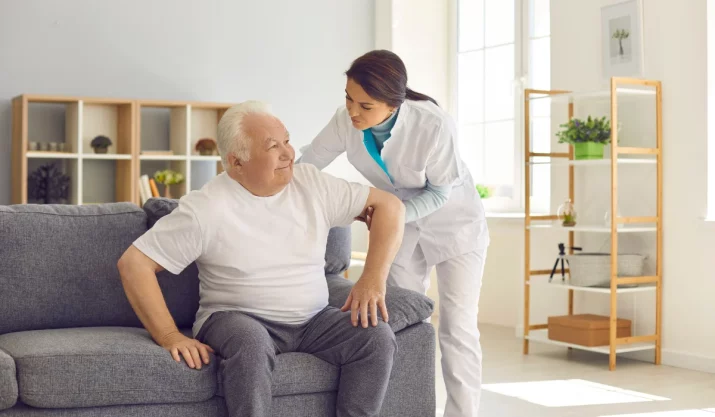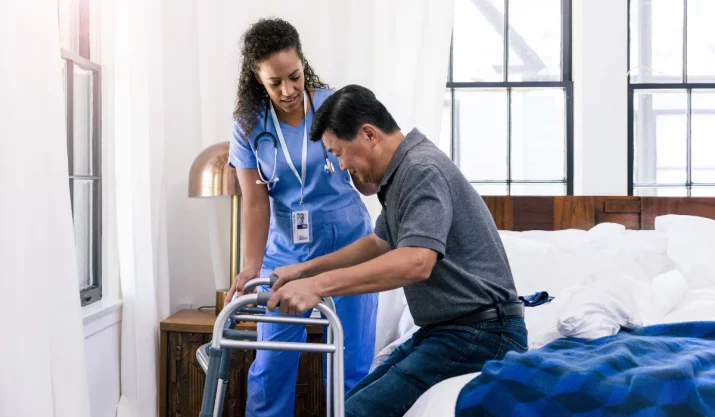What to Expect After Knee Replacement Surgery

Table of Contents
- Key Takeaways
- Day of Surgery: First Steps Toward Healing
- First 24 Hours: Gentle Movement Begins
- Week 1: Building Strength and Managing Pain
- Weeks 2-3: Improving Mobility
- Months 1-2: More Independence
- Months 3-6: Returning to a Normal Routine
- Months 6-12: Full Recovery and Long-Term Care
- Make Your Recovery Smoother and Safer
Knee replacement surgery can help reduce pain and improve movement, especially for people with osteoarthritis. If you’re getting a total knee replacement or partial knee replacement, it’s important to know what recovery looks like.
This guide will walk you through what happens after knee arthroplasty, from the day of surgery to full recovery.
Key Takeaways
- Recovery starts right after surgery with pain medicine, gentle movement, and help from your healthcare team.
- The first few weeks focus on small exercises, managing swelling, and walking short distances with support.
- Most people feel stronger after a few months and can return to normal activities like shopping and light exercise.
- Full recovery takes up to a year, and staying active helps keep your new knee strong for years to come.
Day of Surgery: First Steps Toward Healing
After your knee replacement surgery, you will wake up in the recovery room, where your medical team will check your vitals and make sure you’re comfortable.
You will receive pain medication to help manage discomfort and may be given blood thinners or compression stockings to lower the risk of blood clots.
Your healthcare team will encourage you to move your knee joint as soon as possible.
A physical therapist may visit you to help you sit up and take your first steps with an assistive device like a walker.
First 24 Hours: Gentle Movement Begins
Even though your new knee may feel stiff and sore, moving early is important.
Your healthcare provider will help you start small exercises to improve your range of motion and prevent stiffness.
Swelling is common, so you might use ice packs and keep your leg elevated on a footstool to reduce discomfort.
Your pain management plan may include a mix of over-the-counter and prescription pain medicine to keep you comfortable.
Week 1: Building Strength and Managing Pain
The first week after this type of joint replacement surgery is usually the toughest.
Your pain relief plan will help you move around more easily, and your physical therapist will guide you through simple home exercises.
Many patients need help from a family member or caregiver for daily activities, like getting out of bed or using the toilet seat.
You’ll continue wearing compression stockings to prevent blood clots, and your healthcare team will check for any signs of infection.
Weeks 2-3: Improving Mobility
By the second or third week, you’ll likely feel more comfortable walking short distances with an assistive device.
Your physical therapy sessions will focus on improving knee range and strength.
You’ll have a follow-up appointment with your orthopedic surgeon, where they may take an x-ray to check how well your artificial joint is healing.
Swelling and soreness may still be present, but anti-inflammatory medication and supplements may help.
Sticking to your indoor activities is key to getting back to normal activities faster.
Months 1-2: More Independence
At this stage, most patients can walk without a walker or cane and get back to light everyday activities. You might still feel discomfort when navigating stairs, but your physical activity will continue improving.
Your activity level will increase, and you may feel ready to return to work if your job is not physically demanding.
Your healthcare provider will guide you on when it’s safe to drive again.
Months 3-6: Returning to a Normal Routine
By now, your new knee should feel much stronger.
Most patients can do more normal activities, such as shopping, social outings, and light exercise. Your physical therapist may clear you for low-impact activities like swimming or cycling.
If you still have stiffness, continuing physical therapy and home exercises will help you reach full recovery.
Months 6-12: Full Recovery and Long-Term Care
Most patients feel fully recovered within a year of their total knee replacement surgery. Your quality of life should be much better, and your knee joint should feel stable and strong.
It’s important to stay active and follow your medical team’s advice to protect your joint replacement for years to come.
You’ll continue having follow-up visits to monitor your progress.
Make Your Recovery Smoother and Safer
Recovering from knee replacement surgery takes time, but each step brings you closer to regaining independence. At California Mobility, we provide stair lifts, ramps, and other mobility solutions to help you move around your home safely while you heal.
Whether you need support getting up and down the stairs or a more accessible way to complete everyday activities, we’re here to help.
Contact us today to learn how our products can make your recovery easier and keep you safe at home.








